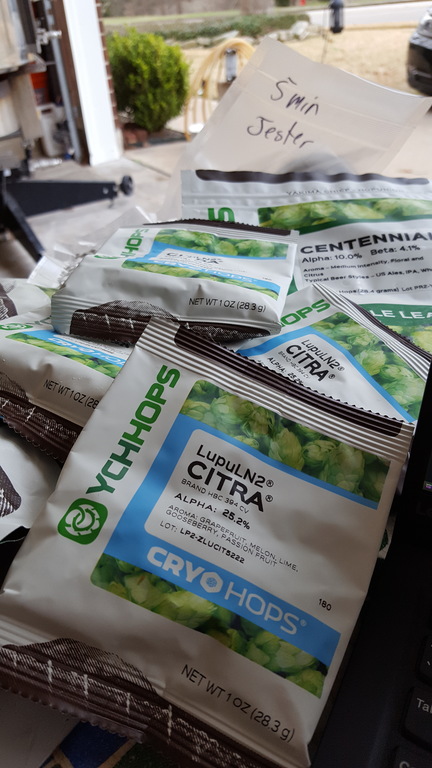
Today’s holiday brew session is another round from the “light and hoppy” styles. I’m pushing this recipe to pull in more farmhouse than North Eastern IPA. I ran across a new-to-me hop, Jester, which is of UK origin but exhibiting some American Hop citrus and fruity characteristics. That sounded really nice for a farmhouse hoppy beer. Brewing NEIPAs though has definitely affected the hop process I used. Normally I would include a bittering addition and something late, maybe a step but save most for dry-hopping but now I’m much more happy with using significantly more hops late and after flame-out.

I’ve also been a bit of a mix of bottling and kegging. Kegging is *so* much easier. So much so that it does tend to make me a bit lazy and skip the effort of bottling; much to my regret. Many of the beers I’ve brewed in years past age extremely well so I’m planning on trying to keep more of it around longer. I’m looking at simplifying my process of bottling with this batch. I’ve got quite a few items that do help the process: 12 bottle rinsing system, drying racks that stack, a pneumatic bottle capper, and two different bottling wands. The main effort is the standing and filling part. I’ve had a Blichmann Beergun for quite some time. I’ve had few issues with it. I also picked up a Last Straw. The Last Straw’s main improvement over the Beergun is how it is held; that helps remove the shoulder ache after filling 15 gallons worth of bottles. The drawback (for me) is that I tend to bottle condition which means filling uncarbonated beer. The diameter restrictions on both fillers slows the entire process down. I recently picked up a wine auto-filler which I’m hoping will make things go a lot faster. It utilizes a pressure switch to automatically stop the flow into a bottle. This is quite effective. My hope is that I’ll be able to hook up two or three of these to a manifold off of the fermentation vessel and then start each bottle which will then stop automatically allowing making it easier to grab the filled bottles, purge with co2 and cap while other bottles continue to fill.

Here’s the recipe for Hoats and Boes:
Recipe Details
| Batch Size |
Boil Time |
IBU |
SRM |
Est. OG |
Est. FG |
ABV |
| 16 gal |
60 min |
54.5 IBUs |
3.2 SRM |
1.030 |
1.006 |
3.2 % |
|
Actuals |
1.046 |
1.01 |
4.7 % |
Style Details
| Name |
Cat. |
OG Range |
FG Range |
IBU |
SRM |
Carb |
ABV |
| Session IPA |
16 |
1.038 - 1.052 |
1.008 - 1.014 |
40 - 55 |
4 - 12 |
2.2 - 2.8 |
3.7 - 5 % |
Fermentables
| Name |
Amount |
% |
| Maris Otter (Thomas Fawcett) |
16 lbs |
88.89 |
| Barley, Flaked |
1 lbs |
5.56 |
| Oats, Flaked |
1 lbs |
5.56 |
Hops
| Name |
Amount |
Time |
Use |
Form |
Alpha % |
| Centennial |
2 oz |
5 min |
Boil |
Leaf |
10 |
| Citra |
2 oz |
5 min |
Boil |
Pellet |
25.2 |
| Jester (UK) |
2 oz |
5 min |
Boil |
Pellet |
6 |
| Centennial |
2 oz |
20 min |
Aroma |
Leaf |
10 |
| Citra |
2 oz |
20 min |
Aroma |
Pellet |
25.2 |
| Jester (UK) |
2 oz |
20 min |
Aroma |
Pellet |
6 |
| Jester (UK) |
4 oz |
3 days |
Dry Hop |
Pellet |
6 |
Miscs
| Name |
Amount |
Time |
Use |
Type |
| Phosphoric Acid 85% |
28.80 ml |
60 min |
Mash |
Water Agent |
| Calcium Chloride |
1.80 g |
60 min |
Mash |
Water Agent |
| Epsom Salt (MgSO4) |
1.80 g |
60 min |
Mash |
Water Agent |
| Gypsum (Calcium Sulfate) |
1.80 g |
60 min |
Mash |
Water Agent |
Yeast
| Name |
Lab |
Attenuation |
Temperature |
| French Saison (3711) |
Wyeast Labs |
80% |
65°F - 77°F |
Mash
| Step |
Temperature |
Time |
| Saccharification |
152°F |
60 min |
| Mash Out |
168°F |
10 min |



